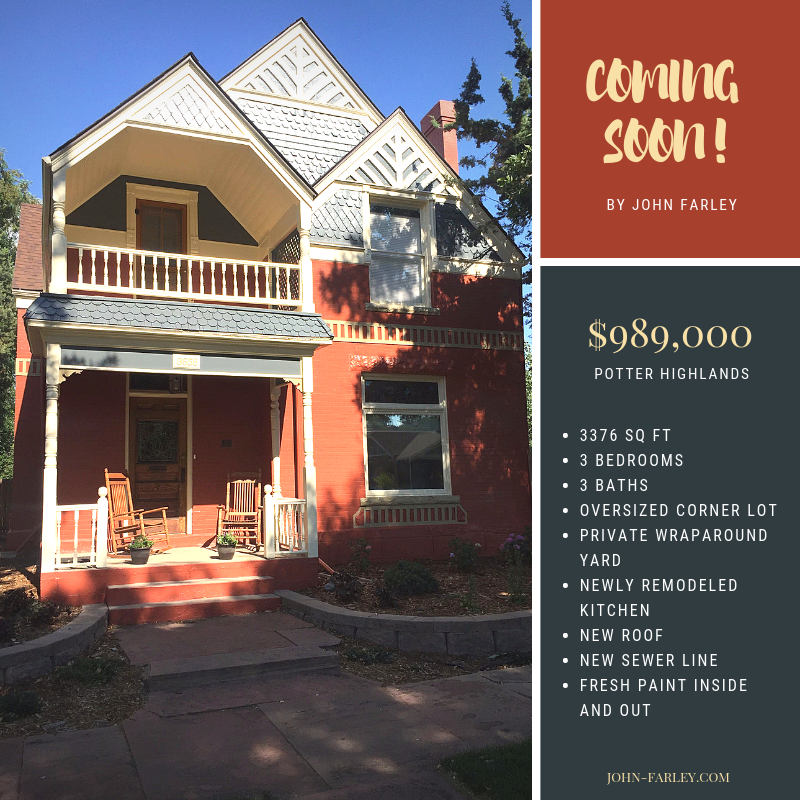by Farley Webmaster | Feb 15, 2019

Coming Soon on 2/28
3376 square feet, 3 bedrooms, 3 baths | $989,000
This beautiful, Potter Highlands, immaculate handcrafted Victorian is situated on an oversized corner lot with a private, wrap around yard. The spacious, light filled home has high ceilings, large windows and inviting space to entertain both inside and out.
Just a few of the updates the current sellers have done include: newly remodeled kitchen, windows rebuilt by Lyons Historic Windows, new roof, new sewer line, fresh paint both inside and out, and the steam shower installed.
Walk or bike to your favorite restaurants, grab a cup of coffee nearby. Unparalleled property that offers a lifestyle opportunity in the heart of Denver.
by Farley Webmaster | Feb 13, 2019

If you’re a current homeowner, or in the market to buy, you’re probably curious about the latest trends in home design.
Sellers who make strategic updates before listing a property can generate increased interest from buyers and, in some cases, a premium selling price. And buyers should consider which features of a home will need updating immediately (or in the near future) so they can factor renovation costs into their overall budget.
Even if you have no immediate plans to buy or sell, we advise our clients to be thoughtful about the colors, materials, and finishes they select when planning a remodel. Making over-personalized or unpopular design choices could hurt a home’s value when it does come time to sell. And selecting out-of-style or overly-trendy elements could cause your renovation to feel dated quickly.
To help, we’ve rounded up eight of the hottest home design trends for 2019. Keep in mind, not all trends will work well in every house. If you plan to buy, list, or renovate a property, consult a professional who can help you realize your vision and maximize the impact of your investment.
1. WARMER PAINT COLORS
White and grey aren’t going anywhere, but expect to see warmer tones and more earthy neutrals popping up in 2019. Cold whites are being replaced by warmer, softer whites. And warmer tones of grey have become a popular alternative to the cooler grays we were seeing earlier in the decade. Dove grey—with a lilac undertone—is a particular favorite with designers this year.
Sherwin Williams chose Cavern Clay, a warm terracotta, as its 2019 color of the year, while Behr selected Blueprint, a mid-tone blue. Benjamin Moore’s selection is Metropolitan, a sophisticated grey.
If you’re preparing to sell your home, consider a light, neutral paint color. Neutral colors provide a blank canvas upon which a buyer can envision placing their belongings, and lighter colors make a room appear larger and brighter.
2. MIXED METALS
Don’t feel limited to using one metallic finish throughout your home—or even throughout a single room. Designers are mixing metals in 2019, and their favorites include copper, brass, pewter, gunmetal, and matte black.
Experts suggest picking one metal hue to dominate your color palette and a contrasting tone to complement it. If your room has a warm color palette, choose a warm-hued primary metal, such as brass or copper. For cool palettes, choose a cool-toned metal, like pewter or stainless steel. You can also experiment with mixing finishes, such as polished and hammered copper.
From faucets to cabinet pulls to accent pieces, swapping out your old or dated fixtures is an easy—and relatively inexpensive—way to modernize your decor. Mixing metals adds depth and gives your room a more curated look.
3. OUTDOOR ELEMENTS
Bringing outdoor elements into the home can help warm up a sterile space. And natural materials can soften a modern design esthetic.
Homeowners are increasingly looking for ways to incorporate these materials throughout their home. Especially popular right now: stone, copper, concrete, and wood. From concrete showers to agate stone tiles, designers are finding unexpected ways to bring the outside in.
One notable exception: granite countertops. Engineered quartz—a combination of ground quartz and resin—overtook natural granite stone as the most popular countertop material in 2018. This durable, low-maintenance, highly-customizable product has won over homeowners and designers alike.
4. ALTERNATIVE APPLIANCES
Stainless steel has been the industry standard for years, but the market is trending toward variety and fresh alternatives. Homeowners have more options available than ever to personalize their kitchens with vibrant colors, black stainless, or modern white appliances. Another favorite? Integrated appliances that blend seamlessly into cabinetry. Built-in column refrigerators, which allow you to customize the design and size of your freezer and refrigerator, are becoming a “must-have” in high-end homes.
Advancements in technology have also brought a new wave of appliances to the market. Induction cooktops are replacing commercial gas ranges as a gourmet favorite. And french door ovens and steam ovens are also gaining in popularity—especially ones with smart features you can control from an app on your smartphone.
5. COLORFUL KITCHENS
White will always be a classic choice, but color is finally coming back to kitchens. More homeowners are choosing cabinets in alternative neutrals like black, cream, and grey, along with colorful options like green and blue. Also popular? Wood cabinets in stains like warm chestnut and fruitwood.
Two-tone kitchen cabinets remain a homeowner favorite, as well. To incorporate this trend, try pairing darker lower cabinets with lighter upper cabinets or a colorful kitchen island with neutral-colored perimeter cabinets.
6. OPEN SHELVING
Swapping upper kitchen cabinets for open shelves continues to be a popular choice in 2019. It’s a cost-effective update that can make a kitchen feel larger and brighter. However, it’s not a practical option for everyone. Before you commit, test it out by removing your cabinet doors for a few weeks. See how it feels to have your glasses and dishware on display.
Not ready to give up all your upper cabinet storage space? Replace just one or two upper cabinets with open shelves for a lower-commitment but still-updated look.
7. STATEMENT TILE
The ubiquitous white subway tile is finally fading in popularity. In 2019, homeowners are gravitating toward more colorful choices, creative textures and finishes, and alternative shapes. Especially hot right now: hexagons, arabesques, diamonds, and Moroccan fish scales.
Natural stone remains a favorite, including marble, quartzite and river rock. But advancements in porcelain tile that mimics stone, and even concrete, has made it an attractive, affordable, and low-maintenance alternative.
8. SHOWCASE CEILINGS
Once an afterthought, ceilings are taking center stage. While 2018 was all about statement walls, statement ceilings are shaping up to be the darling of 2019. Designers are using bold paint colors, wallpaper, intricate moldings, fabric, and other materials to transform a ceiling into something truly special.
Want to incorporate this trend without going too bold? Choose a classic design, like coffered or wooden beams. Or stick with wood paneling or tin tiles for a more timeless look. Even something as simple as painting a ceiling the same color as the walls can make your space feel more modern.
DESIGNED TO SELL
Are you contemplating a remodel? Want to find out how upgrades could impact the value of your home? Give us a call for a free consultation!
Buyer preferences can vary greatly by neighborhood and price range. We can share the insights we’ve gathered from working with buyers in this market … and offer tips on how to maximize the return on your remodeling investment. And if you’re in the market to sell, we can run a Comparative Market Analysis on your home to find out how it compares to others in the area.
Want to learn more about how to stage your home to sell? Contact us at john@john-farley.com to request a free copy of our report: 10 Staging Secrets From the Pros for a Quick Sale at Top Dollar!
Sources:
- Decor Mag –
https://www.decoraid.com/blog/home-design-trends-2019
- Gates Interior Design –
https://gatesinteriordesign.com/hottest-new-kitchen-and-bath-trends-for-2019/
- House Beautiful –
https://www.housebeautiful.com/home-remodeling/interior-designers/a24844028/home-trends-for-2019/
- Houzz –
https://www.houzz.com/ideabooks/114552119/list/32-home-design-trends-that-will-rule-in-2019
- Invaluable –
https://www.invaluable.com/blog/mixing-metals/
- Real Simple –
https://www.realsimple.com/home-organizing/decorating/decorating-tips-techniques/design-trends-2019-according-to-designers
- Sebring –
https://sebringdesignbuild.com/top-trends-in-kitchen-design/
by Farley Webmaster | Jan 16, 2019

As we begin another year, everyone wants to know: “Where is the housing market headed in 2019?”
It’s not only buyers, sellers, and homeowners who are impacted. The real estate market plays an integral role in the overall U.S. economy. Fortunately, key indicators point toward a stable housing market in 2019 with signs of modest growth. However, shifting conditions could impact you if you plan to buy, sell, or refinance this year.
HOME VALUES WILL INCREASE
The value of real estate will continue to rise. Freddie Mac predicts housing prices will increase by 4.3 percent in 2019.1 While the rapid price appreciation we witnessed earlier in the decade has slowed, the combination of a strong economy, low unemployment, and a lack of inventory in many market segments continues to push prices higher.
“Ninety percent of markets are experiencing price gains while very few are experiencing consistent price declines,” according to National Association of Realtors (NAR) Chief Economist Lawrence Yun.2
Yun predicts that the national median existing-home price will increase to around $266,800 in 2019 and $274,000 in 2020. “Home price appreciation will slow down—the days of easy price gains are coming to an end—but prices will continue to rise.”
What does it mean for you? If you’re in the market to buy a home, act fast. Prices will continue to go up, so you’ll pay more the longer you wait. If you’re a current homeowner, real estate has proven once again to be a solid investment over the long term. In fact, the equity level of American homeowners reached an all-time high in 2018, topping $6 trillion.3
SALES LEVELS WILL STABILIZE
In 2018, we saw a decline in sales, primarily driven by rising mortgage rates and a lack of affordable inventory. However, Yun isn’t alarmed. “2017 was the best year for home sales in ten years, and 2018 is only down 1.5 percent year to date. Statistically, it is a mild twinge in the data and a very mild adjustment compared to the long-term growth we’ve been experiencing over the past few years.”2
Yun and other economists expect home sales to remain relatively flat over the next couple of years. Freddie Mac forecasts homes sales will increase 1 percent to 6.08 million in 2019 and 2 percent to 6.20 million in 2020.1
“The medium and long-term prospects for housing are good because demographics are going to continue to support demand,” explains Tendayi Kapfidze, chief economist for LendingTree. “With a slower price appreciation, incomes have an opportunity to catch up. With slower sales, inventory has an opportunity to normalize. A slowdown in 2019 creates a healthier housing market going forward.”4
What does it mean for you?If you’ve been scared off by reports of a market slowdown, it’s important to keep things in perspective. A cooldown can prevent a hot market from becoming overheated. A gradual and sustainable pace of growth is preferable for long-term economic stability.
MORTGAGE RATES WILL RISE
The Mortgage Bankers Association predicts the Federal Reserve will raise interest rates three times this year, resulting in a rise in mortgage rates.5While no one can predict future mortgage rates with certainty, Realtor.com Chief Economist Danielle Hale estimates that the rate for a 30-year mortgage will reach 5.5 percent by the end of 2019, up from around 4.62 percent at the end of 2018.6
While mortgage rates above 5 percent may seem high to today’s buyers, it’s not out of line with historical standards. According to Hale, “The average mortgage rate in the 1990s was 8.1 percent, and rates didn’t fall below 5 percent until 2009. So for buyers who can make the math work, buying a home is likely still an investment worth making.”7
What does it mean for you?If you’re in the market to buy a house or refinance an existing mortgage, you may want to act quickly before mortgage rates rise. To qualify for the lowest rate available, take steps to improve your credit score, pay down existing debt, and save up for a larger down payment.
AFFORDABILITY ISSUES WILL PERSIST
Although the desire to own a home remains strong, the combination of higher home prices and rising mortgage rates will make it increasingly difficult for many first-time buyers to afford one.
“Buyers who are able to stay in the market will find less competition as more buyers are priced out but feel an increased sense of urgency to close before it gets even more expensive,” according to Hale. “Although the number of homes for sale is increasing, which is an improvement for buyers, the majority of new inventory is focused in the mid-to-higher-end price tier, not entry-level.”6
What does it mean for you? Unfortunately, market factors make it difficult for many first-time buyers to afford a home. However, as move-up buyers take advantage of new high-end inventory, we could see an increase in starter homes hitting the market.
MILLENNIALS WILL MAKE UP LARGEST SEGMENT OF BUYERS
“The housing market in 2019 will be characterized by continued rising mortgage rates and surging millennial demand,” according to Odeta Kushi, senior economist for First American. “Rising rates, by making housing less affordable, will likely deter certain potential homebuyers from the market. On the other hand, the largest cohort of millennials will be turning 29 next year, entering peak household formation and home-buying age, and contributing to the increase in first-time buyer demand.”4
Danielle Hale, chief economist for Realtor.com, predicts the trend will continue. “Millennials are also likely to make up the largest share of home buyers for the next decade as their housing needs adjust over time.”6
What does it mean for you? If you’re in the market for a starter home, prepare to compete for the best listings. And if you plan to sell a home in 2019, be sure to work with an agent who knows how to reach millennial buyers by utilizing the latest online marketing techniques.
WE’RE HERE TO GUIDE YOU
While national real estate numbers and predictions can provide a “big picture” outlook for the year, real estate is local. And as Boulder market experts, we can guide you through the ins and outs of our market and the local issues that are likely to drive home values in your particular neighborhood.
If you’re considering buying or selling a home in 2019, contact us now to schedule a free consultation. We’ll work with you to develop an action plan to meet your real estate goals this year.
| START PREPARING TODAY
If you plan to BUY this year:
- Get pre-approved for a mortgage. If you plan to finance part of your home purchase, getting pre-approved for a mortgage will give you a jump-start on the paperwork and provide an advantage over other buyers in a competitive market. The added bonus: you will find out how much you can afford to borrow and budget accordingly.
- Create your wish list. How many bedrooms and bathrooms do you need? How far are you willing to commute to work? What’s most important to you in a home? We can set up a customized search that meets your criteria to help you find the perfect home for you.
- Come to our office. The buying process can be tricky. We’d love to guide you through it. We can help you find a home that fits your needs and budget, all at no cost to you. Give us a call to schedule an appointment today!
If you plan to SELL this year:
- Call us for a FREE Comparative Market Analysis. A CMA not only gives you the current market value of your home, it will also show how your home compares to others in the area. This will help us determine which repairs and upgrades may be required to get top dollar for your property, and it will help us price your home correctly once you’re ready to list.
- Prep your home for the market. Most buyers want a home they can move into right away, without having to make extensive repairs and upgrades. We can help you determine which ones are worth the time and expense to deliver maximum results.
- Start decluttering. Help your buyers see themselves in your home by packing up personal items and things you don’t use regularly and storing them in an attic or storage locker. This will make your home appear larger, make it easier to stage … and get you one step closer to moving when the time comes!
|
Sources:
- Freddie Mac Economic & Housing Research Forecast –
http://www.freddiemac.com/research/pdf/201811-Forecast-04.pdf
- National Association of Realtors 2019 Forecast –
https://www.nar.realtor/newsroom/2019-forecast-existing-home-sales-to-stabilize-and-price-growth-to-continue
- Bankrate 2018 Year in Review –
https://www.bankrate.com/mortgages/year-in-review-for-housing-market/’
- Forbes 2019 Real Estate Forecast –
https://www.forbes.com/sites/alyyale/2018/12/06/2019-real-estate-forecast-what-home-buyers-sellers-and-investors-can-expect/#a98b80a70d9a
- Mortgage Bankers Association Forecast –
https://www.mba.org/2018-press-releases/october/mba-forecast-purchase-originations-to-increase-to-12-trillion-in-2019
- com 2019 National Housing Forecast –
https://www.realtor.com/research/2019-national-housing-forecast/
- FOX Business –
https://www.foxbusiness.com/personal-finance/where-mortgage-rates-are-headed-in-2019
by Farley Webmaster | Dec 9, 2018

The holiday season is upon us, and many of us have already begun to celebrate. From trimming trees to lighting candles, it’s the time of year to fill your homes (and hearts) with holiday joy.
But there’s no need to stop at your front door. Let the spirit of the season radiate outward from your house into your community. Some homeowners hang outdoor lights and decorations to help make the neighborhood “merry and bright.” But that’s not the only way to share the magic of the holidays with others.
Not sure where to start? Check out these 9 inspirational ideas for spreading cheer far and near!
THERE’S NO PLACE LIKE HOME
You probably don’t have to look far to find someone who could benefit from a gift or kind gesture this time of year. Try one (or all) of these ideas for sharing the season with those closest to home.
- Host a Holiday Party
Hosting a neighborhood holiday party is a great way to reconnect with old friends and welcome new families to the community. And it doesn’t necessarily require a huge investment of time or money. Plan a potluck dinner and ask your guests to bring a dish or drink to share. Or host a holiday cookie exchange and ask everyone to bring a couple dozen of their favorite cookie to swap with other guests. Hot cocoa and caroling is another great way to bring neighbors together to celebrate the season.
If you have a neighbor who you’ve been at odds with in the past, consider extending them an invitation, as well. It could be the perfect opportunity to make peace in the new year.
- Help a Neighbor in Need
The holiday season is the perfect time to offer help to a neighbor in need. Next time you head out to rake your leaves, take care of an elderly neighbor’s, as well. Or drop off dinner for a friend who is recovering from surgery.
If you know of someone in your community with a larger need, consider setting up a Care Calendar through a site like CareCalendar.org. Then share the link with other neighbors who may be interested in helping, too. Users can sign up to run errands, cook a meal, babysit, wash laundry, clean the house, mow the lawn, or complete other household tasks depending on the individual’s needs. Even a small gesture of kindness can make someone’s holiday extra jolly.
- Treat Your Mail and Package Carriers
Extend comfort and joy from your own front porch during your postal and package carriers’ busiest time of year.1While many of us love the convenience of shopping online for holiday gifts, the boom in e-commerce has exponentially increased the workload for our postal and package carriers, some of whom work up to 70 hours a week during the holiday season.2
You can help brighten their day by leaving a goody and note of gratitude in your mailbox or a basket of water and snacks by your front door. Attach a sign that says: “Thank you for working hard to deliver our holiday packages. Please take a treat to enjoy on your route!”
DON’T STOP AT YOUR STREET … BRING HOLIDAY CHEER TO EVERYONE YOU MEET
Surprise and delight those you encounter with a small act of kindness or a generous gesture. ‘Tis the season of giving, but the reaction you get in return may be the best gift of all!
- Overtip
Don’t be a Grinch when it comes to tipping at the holidays. Your waiter, your Uber driver, and your hairdresser will all appreciate an extra-generous tip this time of year.
International etiquette expert Sharon Schweitzer recommends that you start by setting a budget for holiday tips and prioritizing those you most want to thank.3Place those who help you most frequently at the top of your list—such as your trusted housekeeper, nanny, or daycare provider. For those you regularly tip at the time service, consider frequency and length of the relationship to determine an appropriate amount.
Everyone could use a little extra cash around the holidays. If you can afford it, share a bit of your abundance with others.
- Thank Those Who Don’t Get a Holiday
Santa isn’t the only one working on Christmas. Emergency workers, hospital staff, airline employees, toll booth attendants, movie theater staff, and many others will be working to make your holiday safe and bright.
Say “thank you” by bringing breakfast to the firehouse or police station on Christmas morning or by dropping off a tray of goodies for the hard-working hospital staff on New Year’s Eve. Keep a stash of treats or coffee-shop gift cards on hand to pass out to those you encounter working over the holidays. And, if appropriate, a generous tip is always appreciated!
- Fill Stockings for the Homeless
Not everyone gets to go “home for the holidays.” You can bring a little cheer and comfort to a homeless person this year with a holiday care kit.
Pick up some inexpensive Christmas stockings from a craft store and fill them with a variety of useful items, such as:
- Applesauce cup (and plastic spoon)
- Baby wipes
- Bandages
- Bottled water
- Beef jerky
- Cereal or granola bar
- Cheese or peanut butter crackers
- Deodorant
- Gloves
- Lip balm
- Lotion
- Nail clippers
- Socks
- Tissues
- Toothbrush and toothpaste
- Tuna and crackers
- Trail mix
As an added touch, include a sweet treat and a handwritten note wishing them a happy holiday. Hand the stockings out at a shelter or keep a stash in your car so you can offer one when you encounter someone in need.
SEND JOY TO THE WORLD BY BECOMING A SECRET SANTA
Reach beyond your sphere by sending some holiday magic out into the community. Surprise a stranger with an anonymous gift that’s sure to make their holiday shine.
- Offer Warmth on a Cold Day
As temperatures drop, some members of our community will be left out in the cold. Our local homeless population is especially vulnerable this time of year, but so are many families living in poverty. Health experts warn that a two-degree drop in body temperature can result in reduced heart rate, lack of coordination, and confusion, making it difficult for adults to work and children to learn.4
You can help by bringing your old but gently-used coats to a collection site. Leave a note in the pocket wishing the recipient a warm and happy holiday. Or tie a scarf around a tree and attach a sign that says: “I am not lost. If you need this to stay warm, please take it!”
Check with local homeless shelters to find out if they accept donations of old blankets. Well-worn blankets and towels can often be donated to an animal shelter to help keep four-legged friends warm this winter, as well.
- Pay Off a Stranger’s Layaway
Some large retailers offer layaway options during the holidays so that shoppers can pay for their purchases a little at a time. Media stories often surface this time of year about anonymous donors who pay off a stranger’s layaway account to the surprise and delight of the recipient.
This is a great way to help a family that may not qualify for charitable assistance but is on a limited budget for holiday gifts. If you have a particular interest in helping kids, you can ask to pay off an account that consists primarily of children’s items.
You don’t have to drop a bundle to become a family’s “Secret Santa.” Ask the layaway attendant to search for accounts with balances that fit within your budget. To make a bigger impact, ask friends and family members if they want to pitch in to help, too.
- Donate Toys to a Tot
One of the most popular ways to give back during the holidays is to participate in a toy drive. There are a number of great charities that collect toys for children of low-income families.
Before you shop, find out if the organization has a wish list of preferred items or guidelines for wrapping and labeling the gift. And check the drop-off deadline to ensure your gift will reach its intended recipient in time.
If you have children, involve them in the process of selecting and purchasing the gift so they can experience the joy of giving to those less fortunate, too.
| One more easy way to support the community this year? Shop local! From locally-owned stores to service providers, please consider spending your holiday dollars here at home. We have an extensive network of Boulder area businesses and would love to recommend some of our favorites. Give us a call, and let us know how we can help! |
Sources:
- NASDAQ –
https://www.nasdaq.com/article/fedex-and-ups-deliver-another-record-holiday-season-cm898487
- The Kansas City Star –
https://www.kansascity.com/news/business/workplace/article189245104.html
- Huffington Post –
https://www.huffpost.com/entry/sharon-schweitzers-2017-holiday-tipping-guide-checklist_b_5a037fc3e4b0c7511e1b398c
- One Warm Coat –
https://www.onewarmcoat.org/theneed/
by Farley Webmaster | Nov 14, 2018

It’s a common misconception that you shouldn’t try to buy or sell a home during the fall and winter months.
This is generally considered the “offseason” in real estate. Many sellers mistakenly believe that the cold weather will keep buyers away and that no one is looking over the holidays. Unfortunately, many real estate professionals perpetuate this myth by advising their clients to “wait until the spring” to list their home.
The truth is, homes are bought and sold year round. And while the market is typically quieter during the fall and winter, savvy buyers and sellers know how to use this slow down to their advantage. In fact, depending on your circumstances, now may be the ideal time for you to purchase or list a home.
If you’re in the market to buy or sell, there’s no need to wait for the spring. Read on to discover the top five reasons that it can pay to buy or sell a home during the offseason!
1. LESS COMPETITION
What’s the number one reason to buy or sell a home during the offseason? Less competition!
This can be particularly beneficial if you’re a seller. Come spring, a huge wave of new listings will hit the market. But if you list now, you will have fewer comparable homes with which to compete.
In the spring and summer months, it can be difficult for your property to stand out in a crowded market. You may end up with a surplus of homes for sale in your neighborhood. Indeed, it’s not uncommon to see multiple listings on a single street during the peak selling season.
Inventory in the fall and winter months, however, can be significantly lower. That means your home will not only receive more attention from buyers, but you may also gain the upper hand in your negotiations. In fact, research found that homes listed in the winter are nine percent more likely to sell, and sellers net more above asking price in the winter than any other time of year.1
Buyers also have a lot to love about the real estate offseason. While some buyers need to move during the winter, many bargain hunters search this time of year in hopes of scoring a great deal.
Smart buyers will continue to scan the market during the fall and winter for hidden gems that pop up during the offseason. There are always highly motivated sellers who need to sell quickly. And with less competition to bid against you, you’re in a better position to negotiate a great price. If you’ve been looking for a good deal on a home or investment property, now may be the best time to look!
So while a “slow market” may scare off some buyers and sellers, it can actually be the perfect time of year for you to list or purchase a home. While the rest of the market is hibernating until spring, take advantage of this opportunity to get a jump start on your competition!
2. EVERYONE’S MORE MOTIVATED
During the spring and summer, you’re likely to encounter “lookie-loo” buyers who are just testing the waters and unrealistic sellers who are holding out for a better offer. But the serious buyers and sellers stay active during the cold weather and holiday season, often because they need to move quickly. In fact, research shows that homes listed in the winter sell faster than any other time of year.1
January and February are peak job hiring months, which brings a surge of buyers who need to relocate quickly to start a new job.2And of course life changes like retirement, marriage, divorce, and new babies come year round. While families often find it more convenient to move during the summer when school is out, the reality is that many don’t have the option to wait. According to the National Association of Realtors, 55 percent of all buyers purchased their home at the time they did because “it was just the right time,” not because of seasonal factors.3
If you prefer to deal with serious, highly-motivated buyers and sellers who want to act fast and don’t want to waste your time, then the offseason may be the perfect real estate season for you.
3. GREATER PERSONAL ATTENTION
Another key benefit to buying and selling in the offseason is the increased personal attention you’ll receive.
While we strive to provide unparalleled client service throughout the year, we simply have more time available for each individual client during slower periods. Similarly, we find the other real estate professionals in our network—including title agents, inspectors, appraisers, insurance agents, and loan officers—are able to respond faster and provide more time and attention during the offseason than they are during the busy spring and summer months. The result is a quicker and more streamlined closing process for all involved.
4. COST SAVINGS
Clients who move during the offseason often report significant cost savings. Moving costs may be discounted by 15 percent or more during the winter months, and moving companies can typically offer more flexibility in their scheduling.4
Home renovations and repairs can also be less expensive in the offseason.5 Whether you’re fixing up your property prior to listing it or remodeling your new home before moving in, contractors and service providers who are hungry for business are often willing to work for a discount this time of year. If you wait until the spring and summer, you may be forced to pay a premium.
Home stagers and decorators are also more likely to negotiate their fees during the winter. And you can often score great deals on new furniture and decor during the holiday sales.
Whether you’re buying or selling, count cost savings as another compelling reason to consider an offseason move.
5. EASIER TO MAINTAIN CURB APPEAL
Finally, listing your home during the fall and winter offers one key—but often overlooked—advantage: less lawn maintenance!
Good curb appeal is crucial when selling your home. According to a recent report by the National Association of Realtors, 44 percent of home buyers drove by a property after viewing it online but did NOT go inside for a walkthrough.6 That means if your curb appeal is lacking, buyers may never make it through the door.
If you list your home during the peak of the selling season, we will generally advise you to implement a frequent schedule of mowing, edging, watering, weeding, and trimming shrubs and hedges. You’ll probably want to plant flowers, as well, to brighten your exterior. After all, a lush landscape is a key element in attracting spring and summer buyers.
If you list in the offseason, however, your lawn maintenance list is significantly reduced. While we do recommend that our sellers keep their exterior clean, tidy, and free of leaves, snow, and ice, you will probably spend much less time on outdoor maintenance during the winter than you would if you listed your home in the summer.
ARE YOU READY TO MAKE YOUR MOVE?
Now that you know all the great reasons to buy or sell a home in the offseason, it’s time to decide whether you’re ready to make your move.
Every client’s circumstances are unique. Whether you need to move quickly or you simply want to take advantages of all benefits this season has to offer, it’s a great time to enter the market.
Give us a call today to schedule a FREE consultation … and you could be ringing in the New Year in your new home!
Sources:
- Redfin –
https://www.redfin.com/blog/2013/12/why-winter-is-the-hottest-time-to-sell-your-home.html#.VjKYm2SrTKI
- Top Resume –
https://www.topresume.com/career-advice/the-best-times-of-the-year-to-job-search
- National Association of Realtors –
https://www.nar.realtor/research-and-statistics/research-reports/highlights-from-the-profile-of-home-buyers-and-sellers
- Angie’s List –
https://www.angieslist.com/articles/why-winter-can-be-best-time-move.htm
- Build Direct –
https://www.builddirect.com/blog/the-best-times-of-the-year-to-get-deals-on-home-remodels/
- National Association of Realtors –
https://www.nar.realtor/sites/default/files/reports/2017/2017-home-buyer-and-seller-generational-trends-03-07-2017.pdf
by Farley Webmaster | Oct 11, 2018

While no one can predict the future with certainty, most experts expect to see modest growth in the U.S. housing market for the remainder of this year and next. Inventory will remain tight, mortgage rates will continue to creep up, and affordability will remain a major issue in many parts of the country.
So what does that mean for home buyers and sellers? To answer that question, we take a closer look at some of the top indicators.
CONTINUED GROWTH IN HOUSING MARKET
There’s good news for homebuyers! In many markets across the country, prices have begun to stabilize after a period of rapid appreciation. Nationwide, home sales experienced a slight decline of 1.6 percent in the second quarter, primarily due to higher mortgage rates and housing prices combined with limited inventory.
However, buyers who have been waiting on the sidelines in anticipation of a big price drop may be disappointed. Demand remains strong across the sector and prices continue to rise. The Case-Shiller U.S. National Home Price Index reported a 6.2 percent annual gain in June, a healthy but sustainable rate of appreciation.1
In its latest Outlook Report, Freddie Mac forecasts continued growth in the housing market due to a strong economy and low unemployment rate, which dropped to 3.9 percent in July.2
“The housing market hit some speed bumps this summer, with many prospective homebuyers slowed by not enough moderately-priced homes for sale and higher home prices and mortgage rates,” according to Sam Khater, Chief Economist at Freddie Mac. “The good news is, the economy and labor market are very healthy right now, and mortgage rates, after surging earlier this year, have stabilized in recent months. These factors should continue to create solid buyer demand, and ultimately an uptick in sales, in most parts of the country in the months ahead.”3
INVENTORY TO REMAIN TIGHT, NEW CONSTRUCTION MAY HELP
Experts predict that demand for housing will continue to outpace available supply, especially in the entry-level price range.
“Today, even as mortgage rates begin to increase and home sales decline in some markets, the most significant challenges facing the housing market stem from insufficient inventory accompanying unsustainable home-price increase,” said National Association of Realtors (NAR) Chief Economist Lawrence Yun in a recent release.
“The answer is to encourage builders to increase supply, and there is a good probability for solid home sales growth once the supply issue is addressed,” said Yun. Additional inventory will also help contain rapid home price growth and open up the market to prospective homebuyers who are consequently—and increasingly—being priced out. In the end, slower price growth is healthier price growth.”4
With so much demand, why aren’t more builders bringing inventory to the market? According to the National Association of Home Builders, a crackdown on immigration and tariffs on imported lumber have made home construction more difficult and expensive. Those factors—combined with the rising cost of land and increased zoning requirements—have put a damper on the industry overall.5
Still, there’s evidence that a modest rise in the rate of new building projects may be on the way. Freddie Mac predicts new housing construction will increase slightly after a stall last quarter.2And a recent report by Freedonia Focus Reports forecasts an annual increase in housing starts of 2.4 percent through 2022, led by an uptick in single-family homes.6 The boost in inventory should help drive sales growth and relieve some of the pent-up demand in tight markets.
While the current lack of inventory is generally preferred by sellers because it means less competition, a combination of high prices and rising interest rates has narrowed the pool of potential buyers who can afford to enter the market. Sellers should seek out real estate agents who utilize technologically-advanced marketing tactics to reach qualified buyers in their area.
AFFORDABILITY REACHES LOWEST LEVEL IN A DECADE
According to a recent report by Morgan Stanley, Americans are paying the most in monthly mortgage payments relative to their incomes since 2008.7And prices aren’t expected to come down any time soon.
“We believe that the current supply and demand environment will continue to push home prices higher, just at a decelerating pace,” said John Egan, Morgan Stanley’s Co-Head of U.S. Housing Strategy.
Fortunately, economists aren’t concerned about affordability levels triggering another housing crisis, as lending standards are much higher today than they were during the run-up before the recession. According to credit reporting agency TransUnion, the share of homeowners who made mortgage payments more than 60-days past due fell in the second quarter to 1.7 percent, the lowest level since the market crash.7
NAR Chief Economist Lawrence Yun agreed with this assessment in a recent statement. “Over the past 10 years, prudent policy reforms and consumer protections have strengthened lending standards and eliminated loose credit, as evidenced by the higher than normal credit scores of those who are able to obtain a mortgage and near record-low defaults and foreclosures, which contributed to the last recession.”4
MORTGAGE RATES EXPECTED TO CONTINUE RISING
The Federal Reserve has taken measures to help keep the housing market—and the overall economy—from overheating. It has raised interest rates twice this year so far, causing mortgage rates to surge in the first half of the year.
Economists predict that the rise in mortgage rates will continue at a more gradual rate through this year and next. The U.S. weekly average mortgage rate rose from 3.99 percent in the first week of January to as high as 4.66 percent in May. Freddy Mac forecasts an average rate of 4.6 percent for 2018 and 5.1 percent in 2019.2
The good news is, mortgage rates still remain near historic lows and a whopping 14 points below the recorded high of 18.63 percent in the early 1980s.8Buyers who have been on the fence may want to act soon to lock in an affordable interest rate … before rates climb higher.
“Some consumers may be thinking that because mortgage rates are higher than they were a year ago, maybe I should just wait until rates fall down again,” said NAR’s Chief Economist Lawrence Yun in a recent speech. “Well, they will be waiting forever.”9
WHAT DOES IT ALL MEAN FOR ME?
If you’ve been waiting to buy a home, you may want to act now. A shortage of available homes on the market means prices are likely to keep going up. And a lack of affordable rental inventory means rents are expected to rise, as well.
If you buy now, you will benefit from appreciating property values while locking in an historically-low interest rate on your mortgage. Waiting to buy could mean paying more for your home as prices increase and paying higher interest on your mortgage as rates continue to rise.
And if you’re in the market to sell your home, there’s no need to wait any longer. Prices have begun to stabilize, and rising interest rates could decrease the number of available buyers for your home. Act now to take advantage of this strong seller’s market.
LET’S GET MOVING
While national real estate numbers and predictions can provide a “big picture” outlook, real estate is local. As local market experts, we can guide you through the ins and outs of the Boulder market and the issues most likely to impact sales and home values in your particular neighborhood.
If you have specific questions or would like more information about where we see real estate headed in our area, let us know! We’re here to help you navigate this changing real estate landscape.
Sources:
- S&P Dow Jones Indices Press Release –
https://www.spice-indices.com/idpfiles/spice-assets/resources/public/documents/766551_cshomeprice-release-0828.pdf?force_download=true
- Freddie Mac Outlook Report –
http://www.freddiemac.com/research/forecast/20180827_strong_economic_growth.html
- DSNews –
https://dsnews.com/daily-dose/08-28-2018/freddie-weighs-in-on-housing-market
- PR Newswire –
https://www.prnewswire.com/news-releases/realtors-chief-economist-reflects-on-past-recession-whats-ahead-for-housing-300702632.html
- CNN Money –
https://www.keyt.com/lifestyle/where-is-the-us-housing-market-headed-4-things-you-need-to-know/787471572
- PR Newswire –
https://www.prnewswire.com/news-releases/us-housing-starts-to-rise-2-4-yearly-to-2022–300711989.html
- Business Insider –
https://www.businessinsider.com/housing-affordability-slowing-market-sales-2018-8
- Value Penguin –
https://www.valuepenguin.com/mortgages/historical-mortgage-rates
- Times Free Press –
https://www.timesfreepress.com/news/business/aroundregion/story/2018/aug/14/despite-prospects-higher-mortgage-rateshousin/476979/










